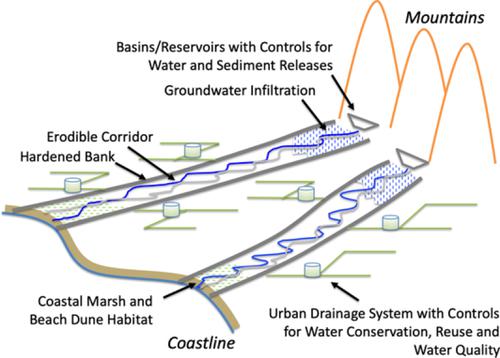当前位置:
X-MOL 学术
›
WIREs Water
›
论文详情
Our official English website, www.x-mol.net, welcomes your feedback! (Note: you will need to create a separate account there.)
Re‐envisioning stormwater infrastructure for ultrahazardous flooding
WIREs Water ( IF 8.2 ) Pub Date : 2020-02-06 , DOI: 10.1002/wat2.1414 Brett F. Sanders 1, 2 , Stanley B. Grant 3
WIREs Water ( IF 8.2 ) Pub Date : 2020-02-06 , DOI: 10.1002/wat2.1414 Brett F. Sanders 1, 2 , Stanley B. Grant 3
Affiliation

|
Ultrahazardous flooding (UHF) occurs on low relief topography at the foot of mountain catchments and is characterized by rapid‐onset, high‐velocity flood flows, large fluxes of sediment and debris, and unpredictable flow paths. 20th century stormwater infrastructure seeks to contain UHF, up to a design level, using combinations of basins, reservoirs and flood control channels. However, these flood control elements may increase the risk of disasters due to: (a) increasingly frequent and intense wildfires that amplify streamflow and debris fluxes beyond infrastructure design capacity; (b) aging and underfunded infrastructure which is susceptible to clogging and failure during extreme events; and (c) expansive urban development where communities are relatively unaware and underprepared for flooding as a consequence of the “levee effect”‐‐the false sense of safety that develops in the presence of flood defenses. 20th century stormwater infrastructure for UHF has also left communities with a legacy of social and environmental challenges including poor water quality, degraded habitats, high maintenance costs, unrealized urban amenities, and altered sediment fluxes. Adopting the Los Angeles Metropolitan Region as a type‐locality for UHF, we propose a new paradigm for stormwater infrastructure based on the concept of erodible flood corridors. Our vision aims for greater sustainability and resilience to extreme events based on congruency with natural processes, conservation of resources and associated ecosystem services, minimization of flood exposure and vulnerability, and avoidance of legacy risk and energy intensive practices.
中文翻译:

重新设想雨洪基础设施以应对超危险洪水
超危险洪水(UHF)发生在山区集水区山脚的低起伏地形上,其特点是起效快,流量大,沉积物和碎屑通量大且流动路径不可预测。20世纪的雨水基础设施力求通过使用盆地,水库和防洪渠道的组合,将UHF控制到设计水平。但是,由于以下原因,这些防洪要素可能会增加灾难的风险:(a)越来越频繁和强烈的野火扩大了基础设施设计能力之外的水流和泥石流;(b)老化和资金不足的基础设施,在极端事件中易于堵塞和故障;(c)由于“堤坝效应”(在存在防洪设施的情况下产生的虚假的安全感)而导致社区相对不了解水灾,对洪灾的准备不足的城市发展。20世纪UHF的雨水基础设施还给社区带来了社会和环境挑战,包括水质差,栖息地退化,维护成本高,未实现的城市设施和沉积物通量变化。我们采用洛杉矶都会区作为UHF的典型地点,我们基于易蚀洪水走廊的概念提出了一种雨水基础设施的新范例。我们的愿景是基于与自然过程,资源节约和相关的生态系统服务的一致性,以实现更大的可持续性和对极端事件的适应力,
更新日期:2020-02-06
中文翻译:

重新设想雨洪基础设施以应对超危险洪水
超危险洪水(UHF)发生在山区集水区山脚的低起伏地形上,其特点是起效快,流量大,沉积物和碎屑通量大且流动路径不可预测。20世纪的雨水基础设施力求通过使用盆地,水库和防洪渠道的组合,将UHF控制到设计水平。但是,由于以下原因,这些防洪要素可能会增加灾难的风险:(a)越来越频繁和强烈的野火扩大了基础设施设计能力之外的水流和泥石流;(b)老化和资金不足的基础设施,在极端事件中易于堵塞和故障;(c)由于“堤坝效应”(在存在防洪设施的情况下产生的虚假的安全感)而导致社区相对不了解水灾,对洪灾的准备不足的城市发展。20世纪UHF的雨水基础设施还给社区带来了社会和环境挑战,包括水质差,栖息地退化,维护成本高,未实现的城市设施和沉积物通量变化。我们采用洛杉矶都会区作为UHF的典型地点,我们基于易蚀洪水走廊的概念提出了一种雨水基础设施的新范例。我们的愿景是基于与自然过程,资源节约和相关的生态系统服务的一致性,以实现更大的可持续性和对极端事件的适应力,



























 京公网安备 11010802027423号
京公网安备 11010802027423号